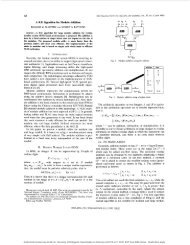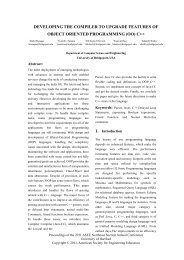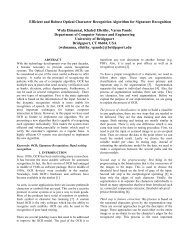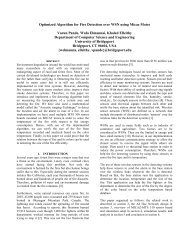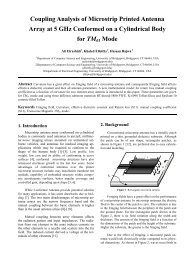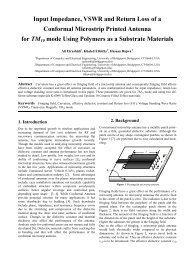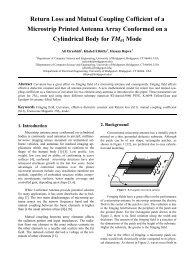Steganography in Arabic Text Using Kashida ... - ResearchGate
Steganography in Arabic Text Using Kashida ... - ResearchGate
Steganography in Arabic Text Using Kashida ... - ResearchGate
Create successful ePaper yourself
Turn your PDF publications into a flip-book with our unique Google optimized e-Paper software.
andom algorithm to distribute the hidden bits <strong>in</strong>side the<br />
message.<br />
B. Ma<strong>in</strong> Contributions and Paper Organization<br />
A promis<strong>in</strong>g algorithm is presented <strong>in</strong> this paper. The ma<strong>in</strong><br />
idea is to use <strong>Kashida</strong> <strong>in</strong> <strong>Arabic</strong> that enables us to hide bits<br />
and remove any <strong>in</strong>truder suspicions. We first <strong>in</strong>troduce four<br />
scenarios to add <strong>Kashida</strong> letters and randomly select one of the<br />
four scenarios for each round. Message segmentation is<br />
applied, enabl<strong>in</strong>g the sender to select more than one strategy<br />
for each block of message. At the other end, the recipient can<br />
recognize which algorithm was applied and can then decrypt<br />
the message content and aggregate it.<br />
The rest of this paper is organized as follows. In Section II<br />
we discuss previous text <strong>Steganography</strong> techniques. <strong>Kashida</strong><br />
variation algorithm <strong>in</strong> <strong>Arabic</strong> hidden algorithm is discussed <strong>in</strong><br />
Section III. Section IV will describe our algorithm and provide<br />
analysis regard<strong>in</strong>g the proposed work. F<strong>in</strong>ally, conclud<strong>in</strong>g<br />
remarks are offered <strong>in</strong> Section V.<br />
<strong>Steganography</strong><br />
Protect Data<br />
Image<br />
Audio<br />
<strong>Text</strong><br />
Cryptography<br />
Symmeric<br />
Asymmertic<br />
Figure 1.Hidden Data classification<br />
II. PRIOR WORKS<br />
<strong>Text</strong> <strong>Steganography</strong> can be classified <strong>in</strong>to three strategies<br />
as shown <strong>in</strong> Figure 1. Each one of these techniques have<br />
advantages and drawbacks. In the follow<strong>in</strong>g section, we will<br />
present some of the prior works and provide some discussions<br />
on them.<br />
Different l<strong>in</strong>guistic methods have been classified <strong>in</strong>to two<br />
categories. The first one is syntax and the other one is<br />
semantic [9]. This work has been developed by creat<strong>in</strong>g a<br />
dictionary of synonyms, and creat<strong>in</strong>g a representation for each<br />
word by bit. Authors <strong>in</strong> [9] presented a novel synonym<br />
algorithm to hide data <strong>in</strong> Bahasa Melayu language, where the<br />
hidden algorithm is divided <strong>in</strong>to two phases. The first step<br />
converts hidden message <strong>in</strong>to b<strong>in</strong>ary codes by us<strong>in</strong>g ASCII<br />
codes. Then a synonyms file is created, where the sender and<br />
recipient must have the same word list to encrypt and decrypt<br />
the message. If the sender wants to <strong>in</strong>sert a Zero, then there is<br />
no need for word replacement. Otherwise, the word from<br />
synonyms file is replaced. The same strategy will be iterated<br />
until the end of the secret message is reached. The recipient<br />
can decrypt the message by an <strong>in</strong>vert<strong>in</strong>g strategy and<br />
compar<strong>in</strong>g if a replacement has occurred, <strong>in</strong> which case the<br />
secret code is 1.<br />
Other similar techniques have been presented <strong>in</strong> [12]. The<br />
algorithm consists of three <strong>in</strong>put sources; natural language;<br />
secret message and the key, and one output which is Stegoobject.<br />
By creat<strong>in</strong>g lexical substitutions set and variant forms<br />
of the same word, and after the first scan, the system will<br />
recognize each word and to which set it belongs to. The lexical<br />
analyzer for Ch<strong>in</strong>ese language is then used to embed the<br />
correct word <strong>in</strong> the carrier file and take the context <strong>in</strong>to<br />
consideration.<br />
L<strong>in</strong>e shift<strong>in</strong>g techniques have been presented <strong>in</strong> [13] by<br />
vertically shift<strong>in</strong>g the l<strong>in</strong>e. In some measurements , are<br />
employed so that secret data can be passed onto it. The ma<strong>in</strong><br />
drawback of this strategy is that character recognition<br />
programs can detect l<strong>in</strong>e shift<strong>in</strong>g. In addition, hidden data will<br />
be discarded by retyp<strong>in</strong>g the carrier document.<br />
Authors <strong>in</strong> [14] <strong>in</strong>troduced Syntactic methods us<strong>in</strong>g<br />
punctuations to pass the secret message by plac<strong>in</strong>g<br />
punctuations <strong>in</strong> proper positions to hide data. This method will<br />
not affect the mean<strong>in</strong>g of the message or the data embedded<br />
<strong>in</strong>side it. On other hand, little amount of data can be embedded<br />
by us<strong>in</strong>g this method.<br />
Authors <strong>in</strong> [12] employed one of the new technology<br />
techniques for Short Messag<strong>in</strong>g Service (SMS). The technique<br />
relies on us<strong>in</strong>g message abbreviation for words, and creat<strong>in</strong>g a<br />
table of abbreviation and description of the message, similar to<br />
Table I.<br />
TABLE I. SMS ABBREVIATION<br />
Abbreviation<br />
Description<br />
AFAIK<br />
As Far As I Know<br />
ABT<br />
About<br />
B4<br />
Before<br />
BTW<br />
By The Way<br />
EOL<br />
End of Lecture<br />
CRAP<br />
Cheap, redundant assorted<br />
products<br />
In [15], a novel text hid<strong>in</strong>g algorithm was proposed us<strong>in</strong>g<br />
chat properties; especially nowadays where chatt<strong>in</strong>g rooms are<br />
very popular. The ma<strong>in</strong> idea <strong>in</strong> this research was to use<br />
emoticons to hide data where tremendous number of those<br />
symbols could be used to hide data <strong>in</strong>side the file. Most of<br />
chat users use emoticons <strong>in</strong>stead words nowadays. So the first<br />
step of this algorithm is to classify symbols semantically and<br />
then control the symbol order by us<strong>in</strong>g a secret key. The work<br />
creates 4 sets of emoticons to hide data. As an example, if the<br />
symbol is <strong>in</strong>serted at the beg<strong>in</strong>n<strong>in</strong>g of sentence, it would pass<br />
0, otherwise the secret bit is 1. Other strategies used <strong>in</strong> this<br />
work rely on symbol order where data can be extracted from<br />
the symbol depend<strong>in</strong>g on the symbol order number <strong>in</strong> its set.<br />
For example, if it is <strong>in</strong> set 4 and order 3, the secret data is



